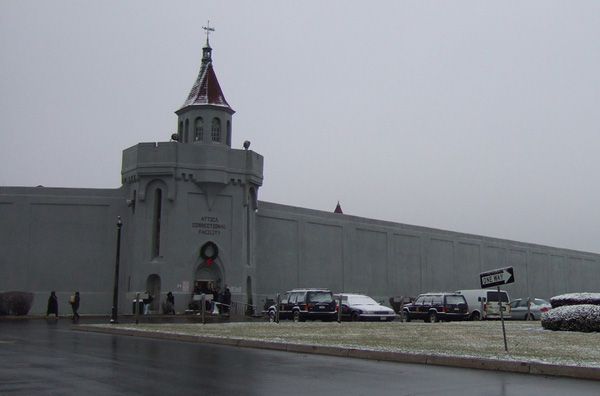
Photo by: Jayu
The legacy of Attica prison is a blemish on New York State and a symbolic reminder of one of the worst periods in its history. If Attica was only a symbolic relic, perhaps its legacy would fade into the past and only be noted in history books. However, the atmosphere at Attica today is what keeps the memory of Attica’s painful past ever present. The problems at Attica are so deeply engrained, and so troubling that the only way to counter the pervasive brutality there is to shut the facility down entirely.
Attica, of course, is the site of the deadliest prison uprising in United States history. Forty-one years ago, 1,300 men incarcerated at Attica rebelled to protest the conditions of their confinement. They put forth a list of immediate demands and practical proposals that included better access to medical care, freedom of religious and political expression, education, living wages, and parole reform. After four days of rebellion, thirty-nine people – 10 guards and 29 incarcerated men – were massacred when New York State Troopers were ordered by Governor Rockefeller to retake the prison.
Attica’s tragic past shadows and dictates its present. Forty-one years after the rebellion, inhumane treatment, sexual misconduct by staff, physical brutality, harassment, racist attitudes, inadequate programming and an atmosphere of violence still shape the profile of the institution.
Attica has a long and troubled history of abuse that is often misunderstood by the public. Utilizing our unique legislative mandate to inspect New York State prisons, the Correctional Association of New York has visited the facility seven times since 1995. The culture of correctional supervision at Attica is unique, even among maximum-security prisons in New York State. The men incarcerated there today are marched two-by-two down the corridors in silent “companies,” with hands out of their pockets pointed down, and their eyes averted. Officers walk alongside the company with a billy club out and at the ready. The scene is reminiscent of the early “congregate model” of the penitentiary back in the early 1800’s.
When we visited Attica in 2011 we found that a few things had changed for the better. There were more GED and college education programs, improved mental health services and better dental care. Those improvements, however, must be measured against the stark fact that out of 167 prisons studied by the Department of Justice in 2008-2009, Attica ranked second highest in the country for allegations of sexual misconduct and abuse by staff.
The improvements must also be measured against pervasive racism and racial tensions. There are over 2.000 people incarcerated at Attica. Eighty percent of them are Hispanic and African American while the staff is overwhelmingly white. With these stark racial disparities, not surprisingly, Attica ranks highest in the state for racial tension and racist attitudes, according to Correctional Association surveys.
In addition to a pervasive sense of tension, intimidation, and fear among the men incarcerated there, we found inadequate programming and a lack of vocational and higher educational opportunities, resulting in routine idleness. Everyone agrees that idleness is a problem that leads to unrest, tension and despair.
Less than a year ago, history was made at Attica again when four Attica guards were arrested and indicted for the brutal beating of a man in their custody and their attempts to cover it up. The victim, George Williams, was seriously hurt in the attack, reportedly suffering from a broken collarbone, two broken legs, and other injuries so serious that he had to endure multiple surgeries.
While this is a particularly shocking and brutal instance of violence, sadly, this is not the first time the Correctional Association has heard about mistreatment of people at Attica, or in other Department of Correctional Services and Community Supervision (DOCCS) facilities. The fact that arrests finally occured at Attica is a testament to how bad things are there.
While the investigation by DOCCS and the arrests were an important step in the right direction, the general atmosphere that existed in Attica in 1971 still pervades nearly every aspect of the facility. Only by closing the prison forever will Attica cease to perpetuate a decades-long cycle of brutality, intimidation, and abuse of authority.
Every September 13th, a tribute is held by the guards at Attica in memory of the 10 officers who were killed in 1971. Sadly, this ceremony refuses to acknowledge the lives of the other 29 people who were killed. That callous disregard for those lives continues to send a chilling message to the people incarcerated at Attica.
Over the years, family members of the victims sued the State for damages because it refused to fully acknowledge its responsibility for the deaths of the 39 victims who were murdered by the state troopers. Despite many requests, no New York Governor has ever apologized to the families of the victims for their deaths.
It is time for New York State to take a step in the right direction. It is time to apologize and it is time to close Attica. The past 41 years have proven that it cannot be fixed. Lack of adequate funding to provide sufficient services and programs, alarming rates of physical and sexual abuse, coupled with a deeply entrenched atmosphere of hostility, and a blatant disregard for human dignity point to only one solution – shut it down and apologize to the victims. In this way, New York can begin a new era; it’s a first step on a long journey. There are troubling conditions in many of New York’s prisons. Closing Attica is a first step towards acknowledging these problems and working to make changes that ultimately could result in a more humane system.







